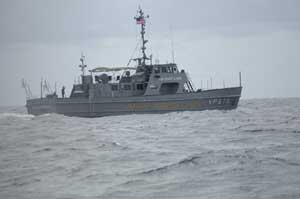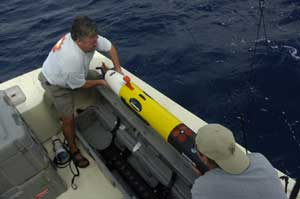The Hunt for the Alligator Hunt for the Alligator Expedition Log for Friday, Sept. 9, 2005 By Michael Overfield
All science team personnel arrived at the YP-679 at 0700 hours to prepare to get underway for our first day of survey. The NAVSEA operators and the unmanned underwater vehicle (UUV) equipped with the high resolution side scan sonar arrived at the dock adjacent to the YP-679 at 0630. The NAVSEA crew boarded the 60-foot fishing vessel RESTLESS, operated by Captain James Winch, and began stowing their gear in preparation for the survey operation they would undertake from this support vessel. The RESTLESS was chosen for its low freeboard (height above water), which would make the UUV easier to deploy and recover in the open ocean. The RESTLESS left the dock at 0715 hours and transited to their survey area The remainder of the science team assembled on the fantail of the YP-679. After a weather briefing and the decision to go ahead with the survey, daily operations and safety briefings were conducted. After some last-minute survey fine tuning, the YP-679 departed Ocracoke Harbor at 0830 hours for the three hour transit to the survey area. Upon arriving at the survey area at 1130 hours, the YP-679 contacted the RESTLESS to ensure sea conditions allowed for the deployment of the UUV. The UUV usually requires a moderate sea state of less than 3-foot waves for launch and recovery. On this first day of survey, the offshore wave height was between 4-6 feet. To our surprise and excitement, the NAVSEA operators were able to deploy their side-scan-sonar-equipped UUV in Area 2.
Aboard the YP-679, the captain, crew and IXSEA representatives Richard Dentzmen and Barry Brake prepared to deploy the Magis magnetometer and begin the survey of Area 1. Four hours of magnetic survey began at 1200 hours and concluded at 1600 hours. Although all survey lines were not completed due to the high winds and higher than anticipated wave action, all anomalies within this survey area were covered to the chief scientist’s satisfaction. The RESTLESS team completed the UUV survey in Area 1 at 1400 hours and returned to Ocracoke to begin downloading their data, charging the batteries in the UUV and begin post-processing their data. The YP-679 concluded the survey of Area 1, retrieved the Magis Magnetometer and began its transit back to port. The sea state became quite lively on the return to Ocracoke as a result of Hurricane Ophelia’s slow progression up the eastern seaboard. What normally takes three hours for the return trip to Ocracoke took the YP-679 close to four-and-a-half hours to complete due to the rapidly changing conditions. The YP-679 arrived at Ocracoke at 2030 hours. As the equipment was powered down and readied for the next day of survey, a satisfaction was felt by all the the day of survey went well. |

